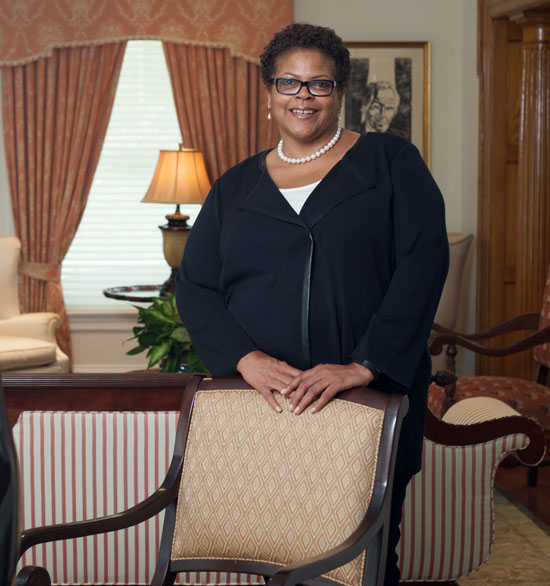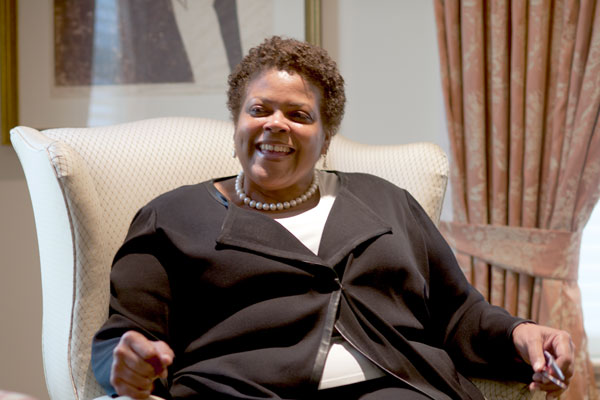In July 2017, Brenda A. Allen became Lincoln’s first alumna president and only the second female president in its 163 year history. In a sit-down interview in the stately 1906 President’s Residence, she recalled her first memories of campus, her most influential professors, and the vision that becomes more crystalized each day she listens to the many stakeholders at Lincoln—a vision that involves returning to Lincoln’s roots as a liberal arts institution.
By the time Brenda A. Allen first stepped foot on Lincoln’s campus for summer placement testing, she was already committed to attending.
She traveled by car from northern New Jersey with her parents, through winding roads surrounded by cornfields brimming with cows and horses, and because the setting was so unfamiliar it was then that she had fleeting second thoughts about her decision to attend the nation’s first degree-granting Historically Black College & University.
But any trace of those hesitancies dissipated when she met the faculty and staff that would be her teachers, mentors, advisers, and counselors for the next four years. She remembers that Lincoln was the first campus that she had visited where she wasn’t referred to as a “minority.”
“I believe in divine intervention, karma,” she says. “It was right.”

While many students from Philadelphia or nearby communities went home on many weekends, Allen spent most weekends on campus, a fact that she sometimes lamented, that is until one weekend she happened to be outside and saw her professor and advisor Henry G. Cornwell jogging on campus.
Cornwell was a 1933 Lincoln graduate and first chair of Lincoln’s Department of Psychology. He taught statistics and instilled in her “a love for numbers, data, and manipulating statistics. ”During that brief encounter, he told her that she was fortunate that she lived so far away and could not get home because that meant she could stay on campus and take advantage of all that the campus afforded—oncampus amenities such as tennis, swimming, bowling.
“In that conversation, my thinking completely changed. I learned how fundamental place is in a student’s experience in college.”
When Cornwell retired, she was the first recipient of the award created in his honor. Throughout her teaching career she has taught statistics and research methods similar to the way he taught his class in the late 1970s.
As a senior, she began applying to graduate schools. Because of her outstanding grades at Lincoln, her professors expected her to get into the top schools. But she didn’t.
“My materials must have been horrible,” she recalls of the admissions materials that she wrote without any review from her professors.
That’s when another influential professor, Dr. Charles Duncan, stepped in and connected her with faculty at Howard University, which is where she would spend the next six years earning her master’s and doctorate degrees in psychology.
Karma had influenced her path again.
“That was the exact place I needed to be,” she says. “Howard worked me like nobody’s business.”
After Howard, she completed a three-year post doctorate program at Yale University, the private Ivy League research university in New Haven, Connecticut. Founded in 1701, it is the third-oldest institution of higher education in the United States and consistently ranked one of the best institutions of higher education in the country.
“It meant greater currency for my Lincoln degree and greater currency for my Howard degree.”
But even though the education and experience gave her an invaluable three years of rigorous academic training, which sharpened her skills and academic prowess, her mind wandered back to her time at Lincoln. “My experiences were so rich at Lincoln.” “While there was so much [at Yale], there was something missing.”
She secured her first tenure-track teaching position at Smith College, a private, independent liberal arts college, located in Northampton, Massachusetts. In 2017, U.S. News & World Report ranked Smith tied for 12th among the best National Liberal Arts Colleges.
A few years after Allen arrived at Smith, Ruth Simmons, who had just become Smith’s president in 1995, invited her into the president’s house to get to know her.
“She asked me what my goal was, and I told her it was to become president at an HBCU, preferably at Lincoln University.”
Right then, Simmons became one of Allen’s strongest allies in formulating and putting plans in place to reach her goal of becoming president at an HBCU.
After she was well-established as a tenured professor, Simmons offered her the role of assistant to the president and director of institutional diversity. At the time, Allen was the only U.S. minority in the sciences at Smith.
“I got good at relationships.”
After three years as chief diversity officer, Allen applied for a new, cabinet-level position at Brown University in Providence, Rhode Island, as associate provost and director of institutional diversity.
Usually diversity positions are housed in other departments, but this position was housed in academic affairs, something that offered Allen the opportunity to recruit and develop faculty.
She was now also broadening her administrative experiences, gaining problem-solving skills across a range of university units including student affairs, human resources, and facilities management.
As the chief diversity officer at Brown, the cabinet-level position provided a look at operations across the university, something that would later be crucial to Allen’s later positions that demanded knowledge of every aspect of operating a university. However, she didn’t see the position as much of a challenge as she was looking for.
Something about that conversation with Simmons during her first days at Smith College still remained with Allen. After six years at Brown, she was adamant about returning to her HBCU roots.
“In some people’s mind it was a step backward to go to an HBCU.”
At the time, Winston-Salem State University, a historically black public research university located in Winston-Salem, North Carolina, was looking for a provost and vice chancellor for Academic Affairs. She was just the person they were looking for.
She served at Winston-Salem for eight years as the chief academic and budget officer with responsibility for all academic and budgetary functions. She reformed the curriculum to ensure a strong liberal arts basis and oversaw the establishment of the school’s first two doctoral programs.

In her first two months at Lincoln, she calls the biggest surprise “that there are no surprises.”
She says that no problem she has encountered is new, however, the same problem that she encountered elsewhere might require a different way to solve it.
“There’s no cookbook recipe for solving a problem.”
“Thank God for all the experiences that prepared me for this position, for all that I went through, for the people who have given me access and engaged me at the table.”
She says she plans to use her collection of experiences — and the experiences of the faculty and staff on campus — to make sure that Lincoln avoids revisiting any past crisis a second time.
Her biggest challenge now: slowing down. “I’m a quick study, always have been, but I have to keep telling myself to slow down, take your time, but also balance that with an urgency for direction.”
Her home on campus in the President’s Residence affords her a quiet place to retreat to and reflect, but also to host gatherings and get to know her new team, just as Ruth Simmons did at Smith College many years ago.
This fall, she wants to focus on defining Lincoln’s market — its branding and what makes it distinctive. To accomplish this, she says she will listen and gather a wide range of input.
At the September board meeting, she plans to have a clear sense of Lincoln’s financial situation, educational philosophy, and student support needs to give them the big picture of the future.
“That’s when I need their support to create a path that’s uniquely Lincoln.”
She says with every conversation, she has the sense that she’s on the right path. Now it’s a matter of getting the plan onto paper—which a consultant will be brought in to assist with—and then operationalizing the plan.
She expects alumni to have a voice in the direction, and she will ensure their voice is heard by asking alumni to serve on the planning committee, going to chapter meetings, holding focus meetings, and using technology to keep those at a distance engaged through livestreaming and surveys.
She says a plan will define what faculty and staff do daily.
“When everyone’s working toward a common goal, you begin to see progress.”
She says by January, her goal is for everyone at Lincoln to be learning what she calls “a new language.”
“Alumni should listen for the language. Everything becomes the language of the community.”
As she did at Winston-Salem, Allen envisions reforming the curriculum to ensure a strong liberal arts basis, which she says is the model Lincoln was founded on.
“We’ve moved farther and farther from the classic liberal arts curriculum.”
Nevertheless, she is confident, “It’s in our DNA.”
The Association of American Colleges & Universities defines a “liberal education” as an “approach to learning that empowers individuals and prepares them to deal with complexity, diversity, and change.It provides students with broad knowledge of the wider world (e.g. science, culture, and society) as well as in-depth study in a specific area of interest. A liberal education helps students develop a sense of social responsibility, as well as strong and transferable intellectual and practical skills such as communication, analytical and problem-solving skills, and a demonstrated ability to apply knowledge and skills in real-world settings.”
She envisions Lincoln giving every student —especially those from underserved populations — a quality 21st century liberal arts education where students learn critical thinking, both inside and outside the classroom. A curriculum where choice, freedom, and exploration are encouraged.
She says the student’s major becomes secondary because they learn to be problem solvers.
“So they can go out into the world and be whatever they want to be.”
She says of her own education at Lincoln, “I didn’t leave just knowing psychology.”
“Lincoln students can learn about the history and culture of African Americans, not in place of the cannons in their field, but to understand how they fit, to gain a broader perspective.”
What will it take to get us to this model of a liberal education? She says this fall the University will rethink the master plan and rethink how staff and faculty do their work. The University will need to make a greater investment in faculty and staff.
“She acknowledges that this rethinking will come at a cost. “High touch is high cost.” It will mean raising more funds and allocating the dollars we have more effectively.
This story originally appeared in the Fall 2017 Lion.